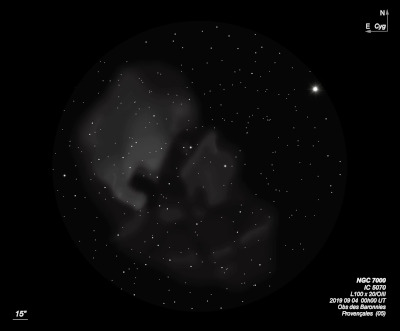North America Nebula
North America Nebula

William Herschel discovered NGC 7000 = H V-37 = h2096 on 24 Oct 1786 (sweep 620) and recorded "vL. Diffused nebulosity plainly visible, bM, 7 or 8' length, 6' broad and losing itself gradually." In the next few minutes of the sweep he also commented, "All this time suspected diffuse nebulosity through the whole breadth of the sweep." He gave two positions at the east and southwest coast of the North American nebula, which became numbers 44 (Southeast US) and 46 (Central America region) in his list of 52 regions with "extensive diffused nebulosity." Arthur Auwers wrote (in a review of the General Catalogue) that JH omitted this large object, but NGC 7000 = GC 4621.
German Astronomer Max Wolf referred to this HII region as "The 'America' Nebula" in a 1902 German paper based on an image taken in 1901. In the 1903 paper "Diffused nebulosities in the heavens", Barnard refers to the object photographed by Wolf and states "The "North America Nebula" would perhaps be more definite, for it is North America to which Dr. Max Wolf intends the compliment." Agnes Mary Clerke refered to it as the "America" Nebula in the caption of Wolf's photograph in her 1905 second edition of "The System of the Stars"
200/250mm - 8" (5/26/84): bright, very large, sharp border and details around the "Gulf" section, "Southwest border" and "Baja region". Rich with faint stars. Viewed with a Rich Field adapter at 33x-50x.
80mm (8/23/84): striking contrast at 16x using a filter at Mt. Rose.
80mm (5/26/84): bright with a well-defined "Gulf" region at 13x using a narrowband filter.
400/500mm - 17.5" (7/17/93): at 100x and OIII filter appears very bright, extremely large (fills several fields), amazingly high contrast around the "Gulf" of Mexico and "Baja" region (LDN 935) and to a lesser extent along the west and east coasts. I traced around the entire border except for the "Canada" region, which consists mostly of scattered star fields with weak nebulosity. The open cluster NGC 6997 is easily picked out in the NE section.
Naked-eye - Easy naked-eye glow in a dark sky, though this is mostly from the rich Milky Way star cloud and not the involved nebulosity. The contrast is highest on the southwest side where the star cloud and nebulosity is adjacent to the dark "Gulf of Mexico" region.
Notes by Steve Gottlieb